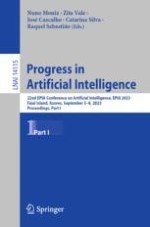The two-volume set LNAI 14115 and 14116 constitutes the refereed proceedings of the 22nd EPIA Conference on Progress in Artificial Intelligence, EPIA 2023, held in Faial Island, Azores, in September 2023.
The 85 full papers presented in these proceedings were carefully reviewed and selected from 163 submissions. The papers have been organized in the following topical sections: ambient intelligence and affective environments; ethics and responsibility in artificial intelligence; general artificial intelligence; intelligent robotics; knowledge discovery and business intelligence; multi-agent systems: theory and applications; natural language processing, text mining and applications; planning, scheduling and decision-making in AI; social simulation and modelling; artifical intelligence, generation and creativity; artificial intelligence and law; artificial intelligence in power and energy systems; artificial intelligence in medicine; artificial intelligence and IoT in agriculture; artificial intelligence in transportation systems; artificial intelligence in smart computing; artificial intelligence for industry and societies.
